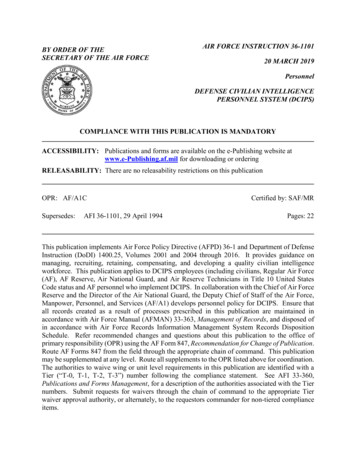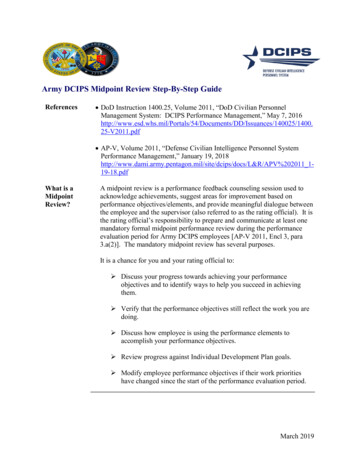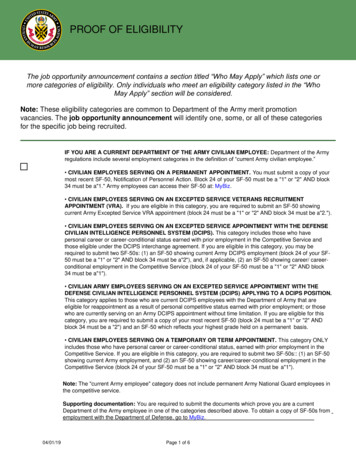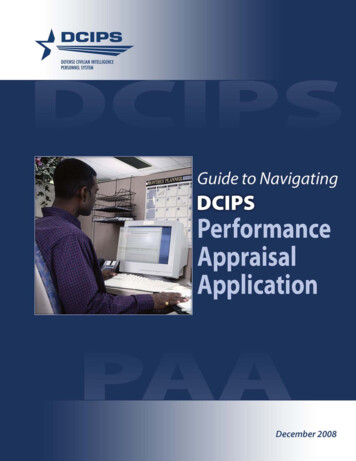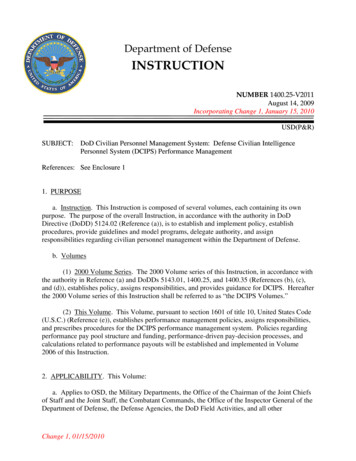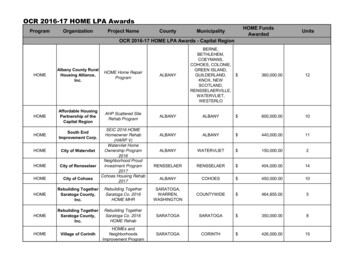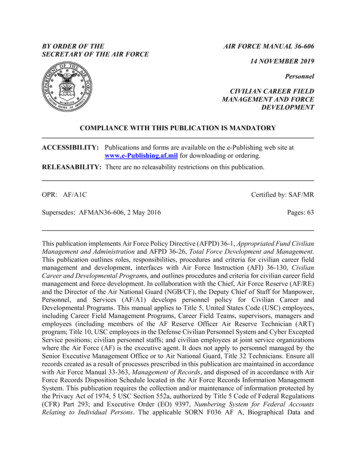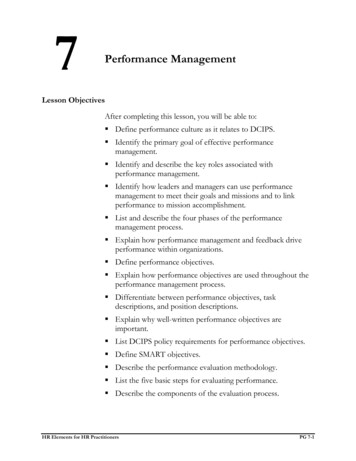
Transcription
7Performance ManagementLesson ObjectivesAfter completing this lesson, you will be able to: Define performance culture as it relates to DCIPS. Identify the primary goal of effective performancemanagement. Identify and describe the key roles associated withperformance management. Identify how leaders and managers can use performancemanagement to meet their goals and missions and to linkperformance to mission accomplishment. List and describe the four phases of the performancemanagement process. Explain how performance management and feedback driveperformance within organizations. Define performance objectives. Explain how performance objectives are used throughout theperformance management process. Differentiate between performance objectives, taskdescriptions, and position descriptions. Explain why well-written performance objectives areimportant. List DCIPS policy requirements for performance objectives. Define SMART objectives. Describe the performance evaluation methodology. List the five basic steps for evaluating performance. Describe the components of the evaluation process.HR Elements for HR PractitionersPG 7-1
Lesson 7: Performance ManagementParticipant Guide List and explain the six standard performance elements andthe two variances for managers/supervisors. Explain the evaluation process for performance elements. Given performance objectives and elements ratings, calculatefinal ratings for performance objectives and performanceelements, and determine the overall Performance Evaluationof Record. Describe the informal and formal reconsideration processesavailable under DCIPS policy.TopicsLesson 7 Introduction . 3Topic 1: Performance Culture . 5Topic 2: Key Roles . 6Topic 3: Performance Management Process . 8Topic 4: Exploring Performance Objectives. 22Topic 5: How Performance is Evaluated . 34Lesson 7 Review. 58PG 7-2HR Elements for HR Practitioners
Participant GuideLesson 7: Performance ManagementLESSON 7 INTRODUCTIONThis lesson lasts 1 hour, 30 minutes.Lesson 7: PerformanceManagementDuration: 1 hour, 30 minutesHR Elements for HR PractitionersPerformance ManagementSlide 8- 1 1 This lesson explains the process for evaluating individual performance underDCIPS policy. When completed, you will be able to provide the SMART objective training toyour workforce or otherwise be able to assist your organization’s rating andreviewing officials in writing performance objectives.Your Notes:HR Elements for HR PractitionersPG 7-3
Lesson 7: Performance ManagementParticipant GuideLesson 7 TopicsLesson 7 Topics Topic 1 – Performance CultureTopic 2 – Key RolesTopic 3 – Performance Management ProcessTopic 4 – Exploring Performance ObjectivesTopic 5 – How Performance is EvaluatedAdditional performance management training canbe found at http://dcips.dtic.mil/training.htmlHR Elements for HR PractitionersPerformance ManagementSlide 7- 22 Building a culture of communication between managers/supervisors andemployees is central to the DCIPS performance management process. DCIPS 101 and other recommended online courses that teach the specifics of theDCIPS performance management process can be found athttp://dcips.dtic.mil/training.html Actively managing performance creates an equitable process for appraising andevaluating employee performance within and across the Defense IntelligenceEnterprise.Your Notes:PG 7-4HR Elements for HR Practitioners
Participant GuideLesson 7: Performance ManagementTOPIC 1: PERFORMANCE CULTUREPerformance CulturePerformance CultureWith the intention of producing remarkable results, the Defense Intelligenceperformance culture embraces:InnovationCollaborationHR Elements for HR PractitionersPerformance ManagementTeamworkSlide 7- 3 3 The overarching goal of effective performance management is to improveperformance and produce results that are driven by the mission.Your Notes:HR Elements for HR PractitionersPG 7-5
Lesson 7: Performance ManagementParticipant GuideTOPIC 2: KEY ROLESKey RolesKey Performance Management RolesEmployeeRating OfficialReviewing OfficialHR Elements for HR PractitionersPerformance ManagementPM PRASlide 7- 4 4What You Should Know:Key Performance Management Roles Defense Intelligence Employee: A person within the Defense IntelligenceEnterprise who: Helps develop, or provides input to, his/her performance plan andIndividual Development Plan (IDP) Self-monitors progress according to his/her performance plan throughoutthe year Takes advantage of formal and informal communication opportunitiesthroughout the performance period Provides input to the Midpoint Review per Component direction Writes a self-report of accomplishments for his/her annual PerformanceEvaluation of Record Employees on Joint Duty Assignments at a Defense Intelligence Component willbe evaluated by that Component as long as the employee has been under theperformance plan for greater than 90 days. DCIPS and JDA policy providePG 7-6HR Elements for HR Practitioners
Participant GuideLesson 7: Performance Managementspecific guidance on handling performance evaluations of Joint Duty employees. Rating Official: An individual in an employee’s chain of supervision (generallythe supervisor) responsible for: Conducting performance planning Managing performance throughout the evaluation period Rating performance against the standards Preparing the end-of-year Performance Evaluation of Record for eachemployee Reviewing Official: An individual, generally in the Rating Official’s chain ofsupervision, who is responsible for reviewing and approving performance plansand evaluations. The Reviewing Official reviews them for accuracy, equity acrossemployees, and compliance with DCIPS policy. The Reviewing Official is theapproving official for each performance evaluation within his or her purview, butcannot approve performance evaluations until after the PM PRA has provided hisor her approval and released them as final. Performance Management Performance Review Authority (PM PRA): TheSenior employee or board who is responsible for oversight of the performancemanagement processes. The PM PRA provides oversight of the evaluationprocess, verifies compliance with merit system principles, and completes a finalreview before Performance Evaluations of Record are final.o The PM PRA has the authority and responsibility to withhold approval anddirect changes to align to policy and the process if the PM PRA believeschanges are required.o The PM PRA also resolves requests for formal reconsideration. Exceptwhere the PM PRA is the Head of the Defense Intelligence Components,the PM PRA should be at a higher level within the organizational hierarchythan the most senior reviewing official participating in the performanceevaluation process. Where separation is not possible, the PM PRA will be asenior employee or panel not in the chain of supervision for thePerformance Evaluations of Record under consideration.Your Notes:HR Elements for HR PractitionersPG 7-7
Lesson 7: Performance ManagementParticipant GuideTOPIC 3: PERFORMANCE MANAGEMENT PROCESSPerformance Management ProcessPerformance Management ProcessHR Elements for HR PractitionersPerformance ManagementSlide 7- 5 5 The DCIPS performance management process consists of three overarchingprinciples and four primary phases. In your group, research and provide a summary of the performance managementphases to which your group has been assigned. Document your findings and those of the other groups on the following page.What You Should Know:Performance Management Process The three overarching principles of the performance management process are: Planning Managing Evaluating The four phases of the performance management process are: PlanPG 7-8HR Elements for HR Practitioners
Participant GuideLesson 7: Performance Management Develop and Monitor Rate Reward The standard evaluation period runs from 1 October through 30 September eachyear unless an exception has been granted by the USD(I).The Four Performance Management PhasesPlan The performance evaluation period officially begins on October 1* of each yearwith the Plan phase. During this phase, managers/supervisors engage theiremployees in dialogue to establish clear performance expectations for theevaluation period that support and align with the mission and goals of theDefense Intelligence Enterprise, the National Intelligence Strategy, organizationalprogram and policy objectives, annual performance plans, and other measures ofperformance. The employee’s performance plan documents those expectationsthrough SMART performance objectives and standard performance elements.*Note: Some Components have received approval to deviate from the October 1start date. A performance plan contains: SMART performance objectives, which are specific descriptions ofwhat the employee needs to accomplish during the evaluation period.In DCIPS, performance objectives are written to the Successfulperformance level. Six standard performance elements, which focus on how theperformance objectives are to be achieved. The performance elementsare standard across the Intelligence Community. Writing the performance plan is a manager /supervisor’s responsibility, but,ideally, it results from dialogue between the manager/supervisor and input fromthe employee. Once established, the employee should clearly be able to see howhis/her efforts and contributions support mission accomplishment andunderstand how the performance elements factor into the performance evaluationprocess. In addition to the performance plan, employees and managers/supervisorscollaborate on the employee’s individual development plan (IDP). This plandocuments the employee’s developmental goals and should be used for long rangeplanning. There is no standard DCIPS format for an IDP; Components mayHR Elements for HR PractitionersPG 7-9
Lesson 7: Performance ManagementParticipant Guidedetermine the appropriate format at the Component level. Rating Officials and Reviewing Officials need to have a shared understanding ofperformance standards, types of work expected at specific band and grade levels,what constitutes a well-crafted performance objective, and the criteria forevaluating their employees. To accomplish this shared understanding, RatingOfficials and Reviewing Officials should meet at the beginning of the evaluationperiod to discuss construction of employee objectives and continue thiscommunication throughout the evaluation period. Reviewing Officials ensure that performance and individual development plansare established for all employees in accordance with established timelines. Once the Reviewing Official approves the performance plan themanager/supervisor communicates (face-to-face, e-mail etc.) and provides a copyto the employee.Develop and Monitor The Develop and Monitor phase continues throughout the performanceevaluation period. At the heart of this phase is regular meaningful dialogueregarding the employee’s performance. Face-to-face is the preferred method ofdialogue with an employee for performance-related discussions. It is recognized,though, that geographic or other forms of separation make such dialogue difficultor even impossible. In such cases, telephone or e-mail exchanges should be usedto ensure ongoing dialogue. The performance dialogues may include events or obstacles that support or deterprogress, modification of objectives (at least 90 days prior to the end of theperformance cycle), employee developmental needs, or other factors affecting thesuccess of the employee and the organization. Although managers/supervisors have the primary responsibility for providingfeedback to employees, employees share the responsibility of identifying andcommunicating successes and difficulties related to their assigned performanceexpectations. Employees should take advantage of opportunities to talk with, or“check-in” with their supervisors in both formal and informal dialogue. At the midpoint of the evaluation period, employees and their Rating Officials(usually their managers/supervisors) hold a Midpoint Performance Reviewconversation that includes formally documenting that the performance discussionoccurred. The date of the Midpoint Performance Review is documented in theperformance evaluation system used by the Component. Narratives documentingprogress toward meeting performance objectives may be required by aComponent. Components may provide specific guidance on such narratives, e.g.,PG 7-10HR Elements for HR Practitioners
Participant GuideLesson 7: Performance Managementone overall narrative, a separate narrative for each objective, etc. The Componentmay require evaluations at the midpoint. Midpoint reviews are sent to ReviewingOfficials for approval. Informal feedback should be frequent and meaningful. The formal MidpointPerformance Review conversation is a time to acknowledge achievements andsuggest areas for improvement. It is important to remember that if there are areasof concern with an employee’s performance or behavior, a supervisor should notwait until the formal midpoint to discuss the situation with the employee, butshould initiate corrective action as appropriate. Reviewing Officials ensure that subordinate Rating Officials provide performancefeedback throughout the evaluation period and Rating Officials have documentedat least one Midpoint Performance Review feedback session with each employee. To ensure that managers/supervisors and employees recall important events andaccomplishments during the year, it also is useful for both to documentperformance as it occurs. Managers/supervisors should encourage employees to seek professional andtechnical development opportunities to enhance their contribution to theorganization’s mission and goals. Development opportunities may includetraining, mentoring, coaching, and other offerings to improve skills and should bedocumented in the IDP.Rate An integral part of the performance management process is themanager/supervisor’s assessment of an employee’s performance related toperformance objectives and performance elements. DCIPS policy provides one general standard for rating performance objectives soeveryone uses a consistent and transparent approach. The general standard is usedin conjunction with the performance objectives, which are written to describeexpected accomplishments at the “Successful” evaluation level. The generalstandards for rating performance objectives and elements are found in DoDI1400.25-V2011. DCIPS policy provides standards for rating performance elements so everyoneuses a consistent and transparent approach. The six performance elements andrelated standards are consistent throughout the IC and the Defense IntelligenceEnterprise and were developed for the employee’s work level. To begin the process, the employee completes a self-report of accomplishments.This report is required of all employees and provides an assessment of theemployee’s performance. Managers/supervisors consider this information inHR Elements for HR PractitionersPG 7-11
Lesson 7: Performance ManagementParticipant Guidecompleting the narrative and numerical evaluation. (Note: The employee’s selfreport is simply for the Rating Official’s consideration. The Rating Official isneither required nor expected to act on this input. For example, if the employeestates he/she was Outstanding, or did something Outstanding, this does not meanthat the Rating Official must agree with that rating.) Components have the flexibility to determine the format and timeline forsubmitting the self-report of accomplishments for employees within theComponent. For example: Employees may address each performance objective and performanceelement separately. Employees may write a separate narrative for each performanceobjective, but performance elements are addressed within the context ofthe objective narratives. Employees may be permitted to write one narrative addressing allperformance objectives and one narrative addressing all performanceelements. Employees may write one narrative that addresses all performanceobjectives and performance elements. Although any of the formats above are acceptable, the Component should ensurethat all employees prepare their self-report of accomplishments in a consistentmanner and that the preferred format is clearly communicated to all employees. Rating Officials complete formal evaluations, describing the extent to which eachemployee achieved his or her performance objectives and how the employeeperformed against the six standard performance elements that contribute tosuccess. Evaluations are based on observations during the year, notes taken aboutan employee’s performance, and information provided in the employee’s selfreport of accomplishments. Rating Officials also provide an overall PerformanceEvaluation of Record. Based on the employee’s accomplishments on each performance objective whatthe employee accomplished the Rating Official assigns a performance objectiverating (a single numerical score from 1 to 5, expressed as a whole number, with 5being the top rating) to each performance objective. The overall performanceobjective rating is then multiplied by 60%. Next the Rating Official considers how the employee accomplished all theperformance objectives, provides a brief narrative statement, and assigns a rating(a single numerical score from 1 to 5, expressed as a whole number, with 5 beingthe top rating) for each of the six standard performance elements. The averagePG 7-12HR Elements for HR Practitioners
Participant GuideLesson 7: Performance Managementof the individual performance elements ratings is then multiplied by 40%. The overall rating is computed by calculating the weighted average of the overallperformance objective ratings and the overall performance element ratings. If anemployee is assigned a score of 1 (unacceptable) on any performance objective, anoverall rating of 1 (unacceptable) will be assigned. The overall rating is thenconverted to the Performance Evaluation of Record. The Reviewing Official reviews the numerical and narrative ratings with severalconsiderations in mind: Consistency with guidance provided by the Reviewing Official at thebeginning of the evaluation period Congruence between numerical ratings assigned and supportingnarrative Consistency across Rating Officials within the Reviewing Official’sorganizational elements Compliance with merit system principles Adherence to other relevant policy Reviewing Officials are encouraged to collaborate with Rating Officials in theirpurview to support a shared understanding of the process and expectations of theRating Officials. The PM PRA plays a critical role in the evaluation process by conducting a finalreview and approval of all Performance Evaluations of Record within theirpurview to ensure consistency across Rating Officials and Reviewing Officials andcompliance with applicable laws and regulations. DCIPS guidance encourages thePM PRA to engage throughout the performance evaluation process to support ashared understanding by all involved in the process. Additionally, engagingthroughout the process helps build trust between the PM PRA and the Reviewingand Rating Officials, resulting in a smoother process. Performance Evaluations of Record may not be provided to the employee untilthe Reviewing Official and PM PRA complete their review and issue finalapproval.Reward Performance management and pay pools are separate processes that interrelate.The performance management process consists of four phases that extendthroughout the 12-month performance evaluation period. The pay pool process consists of three phases that begin with the onset of theHR Elements for HR PractitionersPG 7-13
Lesson 7: Performance ManagementParticipant Guideperformance management period and end with the pay pool payout in January, aroughly 15-month period. The pay pool process governs the Reward phase.During the pay pool process, the pay pool panel determines performance-basedsalary increases and bonuses for employees in the banded structure andperformance-based bonuses for employees in the graded structure based on thePerformance Evaluations of Record. Payout decisions are then communicated tothe employees. Each Component determines how this information iscommunicated. (Note: The pay pool process is discussed in more detail in Lesson11.)Your Notes:PG 7-14HR Elements for HR Practitioners
Participant GuideLesson 7: Performance ManagementWhat You Should Know:Performance Management Responsibilities OverviewHR Elements for HR PractitionersPG 7-15
Lesson 7: Performance ManagementParticipant GuideWhat You Should Know:PG 7-16HR Elements for HR Practitioners
Participant GuideLesson 7: Performance ManagementWhat You Should Know:HR Elements for HR PractitionersPG 7-17
Lesson 7: Performance ManagementParticipant GuideThe final Performance Evaluation of Record is used as primary performance inputduring the pay pool process. Once the evaluation of record is finalized, theperformance management process for the current evaluation period has ended andthe pay pool process’ “pay” phase commences. While the pay phase of the pay poolprocess is ongoing, the Plan phase of the performance management process beginsagain. The interrelationship between the two processes will be discussed in greaterdepth in Lesson 11.PG 7-18HR Elements for HR Practitioners
Participant GuideLesson 7: Performance ManagementPerformance Management Phases Activity ardHR Elements for HR PractitionersPG 7-19
Lesson 7: Performance ManagementParticipant GuideSpecial SituationsSpecial Situations Employee starts new position 90days from end of evaluation period Employee performs in a new positionor under another Rating Official Employee is on a Joint DutyAssignment Employee has 90 days of civilianservice Employee is on an extended absence Employee transfers to a newComponentHR Elements for HR PractitionersPerformance ManagementSlide 7- 1010What You Should Know:Special Situations in the Performance Management Process The minimum time an employee can perform under a performance plan orindividual objective is 90 days. If an employee starts a position with fewer than 90 days remaining in theperformance evaluation period, the additional days are added to the followingperformance year’s evaluation period. A closeout Performance Evaluation of Record must be prepared if the employeehas performed in a position, or under a rating official, for at least 90 days. If the employee does not perform under a new performance plan or set ofobjectives for at least 90 days, the close-out appraisal will become the finalrating of record for the performance cycle. If the employee does perform under a new performance plan for the sameperformance year as the close-out evaluation was completed, the completedcloseout evaluation will be forwarded to the employee’s rating official forconsideration in the preparation of the performance evaluation of record. Employees on JDA are evaluated by the gaining Component if the employee hadPG 7-20HR Elements for HR Practitioners
Participant GuideLesson 7: Performance Managementat least 90 days of performance in the JDA during the performance cycle. Specialrules apply to JDAs, which can be found in the Joint Duty and DCIPS policy. Inaddition, each Component has a Joint Duty Lead who can help. Employees who have fewer than 90 days of civilian service due to military serviceor Workers’ Compensation absence receive a “presumptive” rating. Thepresumptive rating will be the last Performance Evaluation of Record prior to theemployee’s absence, but may not be less than “Successful.” Extended absences for reasons other than those detailed above, such as long-termtraining, will be handled according to Component policy. DCIPS Performance Evaluations of Record are portable. If an employeetransfers between Defense Intelligence Components within 90 days of the end ofthe evaluation period, the closeout performance evaluation from the oldorganization will transfer to the new organization and will be used as the finalperformance evaluation of record for the performance year. If there are morethan 90 days, the closeout will inform the final rating at the new organization.Your Notes:HR Elements for HR PractitionersPG 7-21
Lesson 7: Performance ManagementParticipant GuideTOPIC 4: EXPLORING PERFORMANCE OBJECTIVESValue of Performance ObjectivesValue of Performance Objectives Aligns work with mission andorganizational goals Communicates the major work to beaccomplished Sets a baseline for successfulperformance Forms the basis for ratings Helps employees see how theirperformance contributes toorganizational resultsHR Elements for HR PractitionersPerformance ManagementSlide 7- 1111 You can learn more about how to write effective performance objectives in theDCIPS courses found at http://dcips.dtic.mil/training.htmlWhat You Should Know:Value of Performance Objectives The design of the performance management process emphasizes employee resultsthat contribute to mission accomplishment. A major feature is the use of SMARTperformance objectives that focus on impact and results. By relating performance objectives to the mission, employees have a positive linkto how their performance contributes to overall organizational results. Generallypeople feel more engaged and willing to do a better job if they understand howtheir work contributes to achieving mission and organizational goals.Your Notes:PG 7-22HR Elements for HR Practitioners
Participant GuideLesson 7: Performance ManagementWhat are Performance Objectives?Performance Objectives Are: Not task or position descriptions Large-bucket items and not the smalldaily job tasks A description of a future situation Appropriate for the employee’sposition and work level Written at the “Successful” level andevaluated against the standards Achievable within the evaluationperiodHR Elements for HR PractitionersPerformance ManagementSlide 7- 1212What You Should Know:What are Performance Objectives? Performance objectives differ from task descriptions; this point is a key one toremember. Task descriptions focus on activities; objectives focus on impact andresults. Performance objectives differ from position descriptions. Position descriptionslist duties and responsibilities and are constant for each position. Performanceobjectives identify what needs to be done by the end of the year and may changefrom year to year. We will discuss SMART objectives later in this lesson. Onlinetraining is available on this topic as well. Performance objectives are large-bucket items and not the small daily job tasks. A performance objective is a description of a future situation. This sentence is themost important one in this lesson. Because it is a description of a situation, you can later ask yourself, “Did my worklead to the situation that was described in the objective?” If the answer is yes, thenyou accomplished the objective. Three to six objectives are common, but three are generally recommended.Employees must have at least one performance objective, and should followHR Elements for HR PractitionersPG 7-23
Lesson 7: Performance ManagementParticipant GuideComponent guidance. Performance objectives must be appropriate to the employee’s position and worklevel. For example, performance objectives for managers and supervisors shouldreflect their managerial and supervisory responsibilities. For managers/supervisors, performance objectives need to discuss theirinvolvement in shaping of individual work products in the unit anddeveloping the leadership skills of subordinate employees throughindividual interactions and coaching. Manager/supervisors’ performance objectives must include goals that focuson integrating the work of the unit into broader organizational contexts andon obtaining the resources (such as people, money, and equipment)necessary to perform the organization’s mission. The performanceobjectives should capture the broad programmatic responsibilities forcreating and leading the programs. While performance objectives are written to an employee’s position, similar orsame objectives can be used for multiple positions if they apply. Objectives are written at the “Successful” level and evaluated against the generalstandards documents, “IC Performance Standards” and “DoDI 1400.25-V2011.” If an employee is working toward goals that span several performance evaluationperiods, managers/supervisors should look at dividing the work into milestonesthat fall within single evaluation periods and use that portion of the work to setthe performance objective. New objectives may be assigned during the evaluation period and existingobjectives may be adjusted during the evaluation period with approval of theReviewing Official. Such changes to the employee’s performance plan must bemade at least 90 days prior to the end of the evaluation period. Objectives that are completed during the evaluation period may be “closed out”(rated as complete) prior to the end of the actual performance evaluation period.Your Notes:PG 7-24HR Elements for HR Practitioners
Participant GuideLesson 7: Performance ManagementUse of Performance ObjectivesUse of Performance ObjectivesWell-written performance objectives are critical to the success of DCIPSbecause they form the basis for performance conversations and decisionsin every
In DCIPS, performance objectives are written to the Successful performance level. Six standard performance elements, which focus on . how. the performance objectives are to be achieved. The performance elements are standard across the Intelligence Community. Writing the performance plan is a manager /supervisor's responsibility, but,
